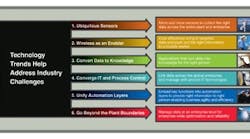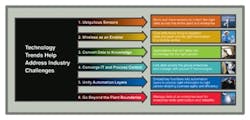Plants don’t need more data. That may sound like a bold statement considering the process industries have placed great emphasis over the last few years on deriving more information from their plant assets with the aim of ensuring smoother and safer production.
There’s an important distinction, though, between deriving more information and deriving the right information. And to effectively meet the challenges that the next few decades will bring, plants need more of the latter.
That’s because technology truly carries as much potential to create bottlenecks for today’s operators as it does to provide valuable and actionable data. Indeed, data overload, combined with the increasing shortage of skilled workers, the growing number of regulations and environmental issues, and pressing safety and security concerns, creates a perfect storm for the automation industry.
All of this has led to the current unenviable situation: fewer skilled people must respond faster, handle more-complex processes, make bigger decisions, and face greater consequences across global enterprises. To create a safer, more efficient and reliable plant, it’s therefore more critical than ever for manufacturers to begin managing the data overload and turning information into real actionable knowledge.
To that end, six key technology trends (Figure 1) will greatly influence how plants cope with the challenges of today and how they’ll operate by the end of the next decade:
1. ubiquitous use of sensors;
2. wireless as an enabling technology;
3. development of applications that turn data into knowledge;
4. convergence of information technology (IT) and process control;
5. unification of automation layers; and
6. data management beyond plant boundaries.
All these trends are well underway and will continue to undergo dramatic changes in the next few years as companies attempt to navigate tricky markets defined by unpredictable demands.
Ubiquitous Sensors
Turning data into knowledge starts with the ability to collect the right data across the plant and enterprise. In this regard, advancements in sensor technology will play a critical role in shaping the plants of the future. As sensors become smaller, more rugged and more reliable, they can pave the way for some truly exciting capabilities to mine for more-meaningful process data.
Some specific areas to watch include:
• microelectromechanical sensors (MEMS). For decades, the concept of using “smart dust” to monitor variables was considered more science fiction than reality. Today, however, industry is truly on the cusp of being able to take advantage of this technology, which could be directly inserted into process liquids to derive unprecedented detail about unit functionality.
• wearable sensors. At many plants wearable sensors already play a valuable role in tracking individuals. Taking this technology a step further by adding fire- and gas-detection capabilities will enable supervisors to know if workers are potentially in danger. For example, is the mobile operator in an environment where hydrogen sulfide content is rising or where oxygen or nitrogen content is changing?
• flying sensors. This safety-enhancing technology is becoming a reality today. If a facility experiences a problem, operators can dispatch a remote-controlled flying device to visually inspect the affected area. These devices can include sensors that, e.g., can detect gas leaks.
• video as a process input. Many plants already have cameras pointing at their flare stacks. Going forward, video will provide more than images — color analysis capabilities will allow operators to use video as an alarm point and variable, for instance, for changes in flare composition.
• embedded sensors. Work is currently underway to develop such devices, which perhaps represent the Holy Grail of process sensing technology. One example is embedding a sensor on a tray in a column to relay information such as liquid loading, temperature and pressure.
These advancements provide more than just additional data points — rather, they furnish more-specific data that truly give operators a greater understanding of how processes are functioning. This type of knowledge ultimately can help operators continually improve production while maintaining a safe environment.
Wireless As An Enabler
Wireless technology has changed how we conduct business and go about our daily lives. And it undoubtedly will alter how manufacturers operate their plants by allowing them to gather data from remote areas (tank farms, for example) where hard wiring is cost-prohibitive. Pipelines stretching across thousands of kilometers, for example, experience thousands of break-ins each year that ultimately lead to costly shutdowns for leak repairs Wireless pressure transmitters, though, provide a cost-effective solution for monitoring pipelines even from hundreds of kilometers away.
But reaching data in remote locations, while probably the most-discussed advantage of wireless, is only one part of the story. In reality, wireless technologies offer several functions that can help plants obtain the most-relevant information.
One major benefit that will take hold as wireless adoption increases is improved two-way information flow between operations, maintenance, engineering, HSE (health, safety and environmental) and other departments that historically haven’t collaborated. With this type of collaboration, wireless can help deliver the right information to the right people at the right time for safer, more-accurate startups and better equipment monitoring. This, in turn, will result in cost and production savings. A major North American refiner, for example, as part of a control-room centralization project, recently installed a wireless network solution that has allowed various departments to better view and analyze data related to tank farm levels, which has led to greater coordination in production, equipment maintenance and employee safety.
Wireless is bolstering safety and security functions within the plant. As previously mentioned, wearable sensors can help protect workers from potentially hazardous situations. Additionally, they allow managers to more easily track individuals during actual emergencies to better coordinate with first responders. In the future, systems will be able to perform functions such as identifying a vehicle located in a unit where startup is imminent and then preventing the startup to ensure safety.
Converting Data To Actionable Knowledge
Unfortunately, gathering information is only half the battle. While improving that process is a strong start, simply providing more data that aren’t actionable certainly does no good. How then can plants make better use of information collected through better sensors and wireless technology?
This is an especially critical issue: statistics show operator error prompts approximately 40% of plant incidents and following incorrect procedures causes 30%.
A key technology trend, therefore, is the move to embed more knowledge into the technology itself to enhance operator decision-making. This approach can help operators take preventive actions to avoid process incidents that could lead to personal injury, costly repair and lost production.
Meanwhile, plants will continue to rely on a technology that’s been around for years — simulation — to better cope as the skill base of staff changes and operators face unfamiliar situations. For instance, because many units now stay online for very long periods, some operators never have executed a shutdown or startup. Simulation will play a crucial role in helping operators decipher vast amounts of information to make better decisions in the control room.
IT-Process Control Convergence
IT and process control historically have operated in their own silos. But as the overall plant becomes integrated, so will these two departments. Stable and emerging standards such as ISA’s SP95 are enabling this integration and clearing a path for capabilities such as:
• service-oriented architecture that delivers common services to support collaboration between manufacturers and partners;
• virtualization that delivers and maintains software while reducing the pain of technology churn;
• cloud computing infrastructures that collect and process data through central locations; and
• software that allows plants to centrally manage open systems despite a shrinking workforce.
Cloud computing is especially intriguing for its ability to tie multiple sites into a common control room and centrally manage many maintenance functions.
The approach has implications for system performance and monitoring, integrated production processes and applications expert support. Many forms of cloud computing are in use today to provide automation and loop-management support. However, pushing cloud computing further into the mainstream will require high-bandwidth networks, advancements in cyber security and greater computing power.
Unifying Automation Layers
The lines between plant automation levels are becoming increasingly blurred every day — business functions, advanced applications and control system platforms are more interconnected than ever before. As a result, more manufacturers are designing programs that link the entire enterprise and, therefore, connecting raw material availability to demand variability.
This strategy will play a major role in delivering specific information to the right people within an organization, along with the right amount of function and control. It starts with gathering data in a common database, establishing standards (e.g., for look and feel) and then distributing those data to various parts of the organization. The idea here is to eliminate time spent by different departments sorting through information that isn’t of value to them.
Specific examples of this unification can be found today in the batch manufacturing industries, such as specialty chemicals and life sciences. Integrated batch solutions, for instance, can deliver increased reliability with batch execution at all levels on a control-level redundant platform. It’s also proven to improve plant efficiency by reducing batch cycle times; this can lead to an annual 1% increase in throughput.
Likewise, great opportunities now exist for pharmaceutical manufacturers to bring manufacturing execution systems into the control rooms to help improve productivity, decrease errors and enable paperless plant operations that significantly reduce regulatory-compliance-related costs.
Going Beyond Plant Boundaries
Plants of the future need better connectivity across the enterprise if they’re truly to drive business results. Wider-spread adoption of common databases and platforms is essential for this trend to take hold. Now, different departments have dissimilar views on operating parameters, including alarm and shutdown points. Building a common database will enable groups within the organization to better collaborate to establish standard limits for processes and operate them in a safer manner.
Going beyond the plant control room can result in a demand-driven supply chain that ultimately maximizes profit. Consider this recent example: an Asian refiner sought to plan the supply chain for complex crude scheduling across multiple facilities. The network included 10 refineries, 200 depots, 40 terminals, 17 pipelines, six transportation modes and 80 crudes sourced worldwide. Using a modeling system, the refiner leveraged input from operator up to executive level regarding supply chain optimization. The company integrated five refineries in only 10 months and implemented a planning process that takes advantage of synergies among procurement, manufacturing, sales and distribution.
The Future Is Officially Here
Going forward, the most critical process that manufacturers will need to optimize may well be data-to-knowledge conversion. As market demands continue to fluctuate amid an uncertain economy, the status quo for process operation simply isn’t the most-efficient, or safest, path to profitability.
The tools plants need to rapidly adapt to these changing demands are largely still taking shape, but manufacturers must begin planning today (if they haven’t already) to incorporate them. Plants that make room now for future technologies will prepare themselves to gain a competitive edge that ultimately can lead to business success.
Norm Gilsdorf is president of Honeywell Process Solutions, Phoenix, Ariz., which can be contacted via [email protected].



